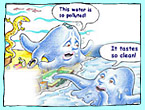
Communicative functions: Interacting with others
| Adjusting our interaction with others |  |
Being positive and negative
When we interact with others, the most direct way to express our point of view is to be either positive or negative:

|
The water in the harbour is
polluted, but the water in the swimming pools isn't
polluted.
The children like chocolate biscuits but they don't like MegaMonster. |
 |
To make a positive clause negative, we add the word not to the verb
group. In spoken language the word not is often contracted and joined to
the auxiliary verb to make a single word. If the verb group does not already
have an auxiliary, we add the auxiliary verb does or do: ![]()
| positive | negative |
| The water in the harbour is polluted. | The water in the swimming pools is not polluted. |
| The children like chocolate biscuits. | The children don't like MegaMonster. |
Here is how positive and negative turns are used to build the interaction in
a children's conversation:
I don't like fish. Don't you? I like tuna and I love those chewy things.
For more information about responding to requests, see:
![]() Text types:
Particular Descriptions: Expressing feelings and opinions
Text types:
Particular Descriptions: Expressing feelings and opinions
![]() Text
types: Recounts: Expressing feelings and opinions
Text
types: Recounts: Expressing feelings and opinions
![]() Text
types: Stories: Building atmosphere and suspense
Text
types: Stories: Building atmosphere and suspense
![]() Grammar: Groups & phrases:
Verb group: Adjusting interactions: modality:
Overview
Grammar: Groups & phrases:
Verb group: Adjusting interactions: modality:
Overview
Teaching activities |
| For PrimeTeach teaching activities which provide
KS2 students with practice in being positive and negative, see:
|
|
||
To give us feedback about this section, click here or on the Comment button at the top of the screen.
If you have any questions about this section, visit the Language Corner.
If you have any questions or suggestions about how to teach this section, send a message to the Teaching Corner.